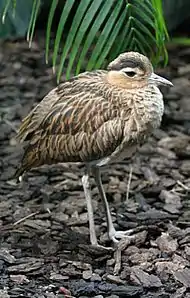Double-striped thick-knee
The double-striped thick-knee (Burhinus bistriatus) is a stone-curlew, a group of waders in the family Burhinidae. The vernacular name refers to the prominent joints in the long greenish-grey legs, and bistriatus to the two stripes of the head pattern.
| Double-striped thick-knee | |
|---|---|
%252C_crop.jpg.webp) | |
| Scientific classification | |
| Kingdom: | Animalia |
| Phylum: | Chordata |
| Class: | Aves |
| Order: | Charadriiformes |
| Family: | Burhinidae |
| Genus: | Burhinus |
| Species: | B. bistriatus |
| Binomial name | |
| Burhinus bistriatus Wagler, 1829 | |
 | |
range | |
Subspecies
There are four subspecies, differing in size and plumage tone, but individual variation makes identification of races difficult.
Range and habitat
It is a resident breeder in Central and South America from southern Mexico south to Colombia, Venezuela and northern Brazil. It also occurs on Hispaniola and some of the Venezuelan islands, and is a very rare vagrant to Trinidad, Curaçao and the USA. It prefers arid grassland, savanna, and other dry, open habitats.
Description
The double-striped thick-knee is a medium-large wader with a strong black and yellow bill, large yellow eyes, which give it a reptilian appearance, and cryptic plumage. The adult is about 46 to 50 cm (18–20 in) long and weighs about 780 to 785 g (27.5–27.7 oz). It has finely streaked grey-brown upperparts, and a paler brown neck and breast merging into the white belly. The head has a strong white supercilium bordered above by a black stripe. Juveniles are similar to adults, but have slightly darker brown upperparts and a whitish nape. The double-striped thick-knee is striking in flight, with a white patch on the dark upperwing, and a white underwing with a black rear edge.
Habits and food
This is a largely nocturnal and crepuscular species. It flies only reluctantly, relying on crouching and camouflage for concealment. The double-striped thick-knee eats large insects and other small vertebrate and invertebrate prey. It is sometimes semi-domesticated because of its useful function in controlling insects, and has benefited from the clearing of woodlands to create pasture. The song, given at night, is a loud kee-kee-kee.
Nesting
The nest is a bare scrape into which two olive-brown eggs are laid and incubated by both adults for 25–27 days to hatching. The downy young are precocial and soon leave the nest.
References
- BirdLife International (2012). "Burhinus bistriatus". IUCN Red List of Threatened Species. 2012. Retrieved 26 November 2013.CS1 maint: ref=harv (link)
- ffrench, Richard (1991). A Guide to the Birds of Trinidad and Tobago (2nd ed.). Comstock Publishing. ISBN 0-8014-9792-2.
- Hilty, Steven L (2003). Birds of Venezuela. London: Christopher Helm. ISBN 0-7136-6418-5.
- Stiles, F. Gary; Skutch, Alexander F. (1989). A Guide to the Birds of Costa Rica. Comstock Publishing Associates. ISBN 0-8014-9600-4.
- Hayman, Peter; Marchant, John; Prater, Tony (1991). Shorebirds. Christopher Helm Publishers Ltd. ISBN 978-0-395-60237-9.
External links
| Wikimedia Commons has media related to Burhinus bistriatus. |
| Wikispecies has information related to Burhinus bistriatus. |
- "Double-striped thick-knee media". Internet Bird Collection.
- Photo of double-striped thick-knee displaying, Photo 2; Venezuela Photo Gallery at Borderland Tours
- Double-striped thick-knee photo gallery at VIREO (Drexel University)
- Double-striped thick-knee species account at Neotropical Birds (Cornell Lab of Ornithology)
- Interactive range map of Burhinus bistriatus at IUCN Red List maps

